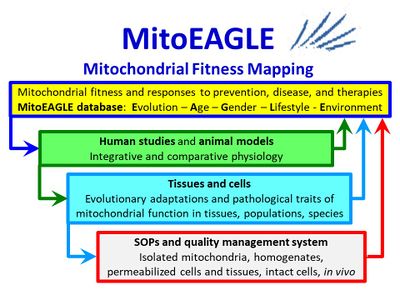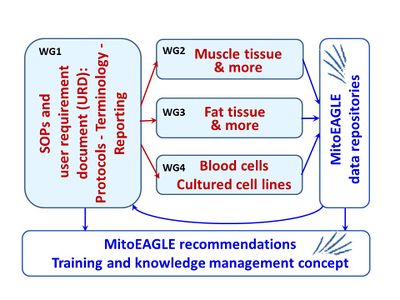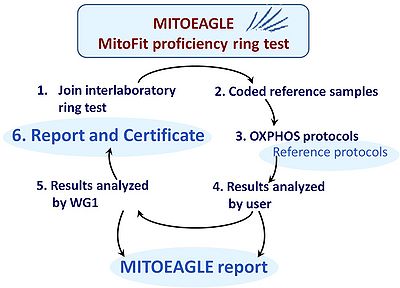| News and Events | Working Groups | Short-Term Scientific Missions | Management Committee | Members |
COST Action CA15203 (2016-2021): MitoEAGLE
Evolution-Age-Gender-Lifestyle-Environment: mitochondrial fitness mapping
MitoEAGLE
COST Action MITOEAGLE approved
* Top news 2016-02-12
- We are happy to inform you that proposal OC-2015-2-19984 Mitochondrial mapping: Evolution - Age - Gender - Lifestyle - Environment was approved by the COST Committee of Senior Officials. - More details: » COST Action MITOEAGLE
* Evaluation highlights
- The proposal addresses the considerable lack of uniformity and consensus on standard operating procedures in the design and implementation of research protocols involving mitochondrial physiology. This is a very real problem that can only be solved through networks on a scale such as this Action, that will work to harmonise experimental protocols across research groups. - More details »MITOEAGLE evaluation highlights
S&T Excellence: Challenge
Every study of mitochondrial function and disease in human tissues and cells is faced with Evolution, Age, Gender, Lifestyle and Environment (EAGLE) as essential background conditions characterizing the individual patient, subject, study group, species, tissue or – to some extent - cell line. This range of factors is too wide to be accommodated in any single project on mitochondrial respiration. Only a large and well coordinated network can manage to generate the necessary number of consistent data to address the complexity of EAGLE. The MITOEAGLE knowledge management network will be a strategic innovation to develop harmonization protocols towards generating a rigorously monitored data repository on mitochondrial respiratory function. A MITOEAGLE data management system is necessary to interrelate results of a large number of studies, to interpret pathological phenotypes, and to set results into the multidimensional context of EAGLE. Clearly, MITOEAGLE must be operated by mitochondrial specialists on a global scale. MITOEAGLE will be a gateway and milestone to better diagnose mitochondrial respiratory defects which are linked to various age-related health risks, including cardiovascular and degenerative diseases, such as type 2 diabetes, neurodegenerative diseases (Alzheimer’s, Parkinson’s, Huntington’s), and several types of cancer (Murdoch 2013 JAMA).
- Relevance and timeliness: Diseases that are strongly related to a sedentary life style are spreading world-wide at an epidemic scale. Mitochondrial dysfunction is increasingly associated with the progression of such pathologies: cause or consequence? There is currently no regimented, quantitative system, or database organised to routinely test, compare and monitor mitochondrial capacities within individuals, populations, or among populations. This reflects the need for scientific innovation and represents a shortcoming in the health system of our modern, rapidly ageing society. Traditional lifestyles of ‘remote’ human populations are dwindling such that these highly significant windows into our evolutionary past are about to becoming closed, forever. While studies of mitochondrial DNA (mtDNA) have become increasingly established in the search for the evolutionary history and diversification of the human species, mitochondrial function remains comparatively unexplored, but may turn out to provide key information for preventing diseases which become prevalent upon transition to a Westernized lifestyle. The presently observed acceleration of research on cell and mitochondrial respiration represents a challenge to transform scientific information into knowledge and translate complex results on mitochondrial (dys)function into a patient-related mitochondrial score. Diagnostic standards, however, are lacking. A concerted action of the scientific community is required to implement quality control systems and optimally harmonize protocols across research groups. The primary challenge is to ‘increase value and reduce waste in research design, conduct, and analysis’, to separate the signal from the noise (Ioannidis 2005; The Lanzet 2014): ‘The signal is the truth. The noise is what distracts us from the truth’ (Silver N: The signal and the noise. The art and science of prediction. Penguin Press 2012).
Objectives
Research Coordination Objectives
MITOEAGLE aims at providing the first standardized measures to link mitochondrial and physiome performance (heart rate, BMI, blood pressure, blood chemistry, VO2max) to understand the myriad of factors that play a role in mitochondrial physiology. The ambitious objective to optimally harmonize protocols across research groups cannot be achieved through projects with limited numbers of partners. Therefore, the COST framework represents an ideal instrument which allows bringing together many groups and experts in the diverse field of mitochondrial physiology. The aim of this Action is to form a unique well-coordinated network of senior researchers and young investigators, to include well established stakeholders, and to establish a spirit of mentorship and collaboration in contrast to fierce competition which characterized early decades of bioenergetics. The COST format is perfectly suited for achieving these objectives.
These objectives will be realised by using the following instruments:
- Network meetings, workshops.
- Working Groups (WG).
- Short Term Scientific Missions (STSM).
- Discussion forum and websites in order to report effectively the COST Action progress.
Members of the MITOEAGLE consortium may be active in more than one WG, thus allowing substantial crosstalk between the groups and interactions between different disciplines.
These instruments are directed towards the following aims of the MITOEAGLE COST Action:
- Intensify the dissemination of updated knowledge and know-how among the partners;
- Build and improve collaborative relationships among the participating groups of the Action and interested end-users;
- Foster coordinated research activities of scientific proposals in the European Research Area;
- Increase the number of active participants in the course of the COST Action;
- Initiate applications for funding to support international collaborative research projects;
- Present and publish results of collaborative research projects within the COST Action, particularly related to STSM supported by the Action.
COST Action MITOEAGLE
The objective of the MITOEAGLE network is to improve our knowledge on mitochondrial function in health and disease related to Evolution, Age, Gender, Lifestyle and Environment. Every study of mitochondrial (mt) function and disease is faced with EAGLE as the essential background conditions characterizing the individual patient, subject, study group, species, tissue or even cell line. To address the complex interrelationships of EAGLE with an initial focus on humans and rodent models, the network will enhance the value of each individual study by starting to analyse and catalog data beyond the published record. Highlighting the topic of mitochondrial function in relation to age, gender, lifstyle and environmental factors, unique new information will emerge on human biology from the development of a European reference database. Protocols, technologies and standard procedures will be compared and strategies defined for improvement of quality control. An interlaboratory proficiency ring test will be established as a world-wide innovation in the field of mitochondrial respiratory physiology. The expertise gained and new standards developed will be integrated into a strategic dissemination and education programme for mitochondrial phenotyping, aiming at an expanding European and MitoGlobal network where researchers collaborate on mapping mitochondrial fitness in physiology and medicine, complementary to established mtDNA databases.
- Further details » COST Action MITOEAGLE
- Keywords
- mitochondrial physiology, gender, aging, oxidative stress, life style, nutrition, sports, degenerative diseases, neurodegeneration, obesity, diabetes, cardiovascular diseases, cancer, latent mitochondrial dysfunction, stress resistance, respirometry, membrane potential, ROS production, redox regulation, isolated mitochondria, homogenate, cells, permeabilized cells, muscle fibres, tissues, model organisms
- MITOEAGLE aims at meeting current demands of the global research community to improve the data base on mitochondrial function/dysfunction in various tissues of humans and animal models, and to diagnose the mitochondrial implications in various pathologies, for development and evaluation of mitochondria-targeted therapies.
- MITOEAGLE opens the feedback loop between the primary problems of attack (gender-specific mitochondrial roles in fitness, aging, pathologies) and the consequential models and methods employed.
- MITOEAGLE will generate the critical mass of partners required to address the complex conceptual and methodological problems that may have prevented so far the major break-though required for addressing the preventable diseases in westernized ageing societies.
- MITOEAGLE is an initiative towards a broad but focussed project, to ‘contribute substantially to the coordination and defragmentation of research efforts across Europe’.
MITOEAGLE Working Groups
The MITOEAGLE consortium brings together research groups involved in studies of mitochondrial function in tissues and cells. The research groups involved include specialists on sports science, nutrition and life style, ageing and human diseases. The consortium is open to extend its scope beyond human tissues and cells, to include rodent models, with particular emphasis on a comparison of mt-function from mouse to man.
A standardized mt-laboratory quality management system (QMSmtf [2]) is required for establishing a global data base on mitochondrial function (mtf) in human cells and tissues, taking into account the variables of evolution, age, gender, life style and environment (EAGLE). A QMSmtf requires the availability of a mt-reference sample which is functionally stable over time and across geographical space, as a basis of standard proficiency tests within and between reference laboratories. Training and knowledge management need to be developed as part of the QMSmtf.
Satellite meetings
Organize a series of meetings of members of the consortium with a minimum of added costs, by integrating EAGLE sessions in regular meetings of established mitochondrial societies. Keep a track record for information flow to attending participants.
Workshops
Satellite workshops will extend the activities of the consortium, which may lead to continuing inter-laboratory studies, development of standards for quality control and teaching initiatives to disseminate and certify such standards for quality control.
Intergration with established and developing databases
Contact organizations and research groups operating comparable genomic and physiological databases, to share their expertise. Interdisciplinary expertise is required on the design of the MITOEAGLE data base, considering the complexities of the logistic, legal and financial aspects.
Links
- CA COST Action CA15110 - Harmonising standardisation strategies to increase efficiency and competitiveness of European life-science research
- OBJECTIVE: The main objective is to avoid duplication and overlap of existing standardisation activities and to achieve a breakthrough in standardisation efforts; the Action aims to bridge, combine and team up with other initiatives. This shall be achieved through a coordinated, long-term strategy by active involvement of all stakeholders from research, industry and policy.
- National Exercise Clinical Trials Network (contact Lai Nicola)
- http://www.uab.edu/medicine/exercise/nextnet
- To share exercise data among the different national labs we are using redcap: http://www.project-redcap.org/
- NINDS Mitochondrial Diseases Common Data Element Project - Public Review Period: November 20, 2014 - January 16, 2015
- Work in progress: MiPMap







